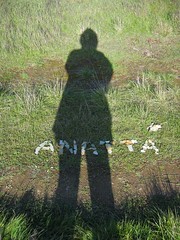Hokusai says look carefully.
He says pay attention, notice.
He says keep looking, stay curious.
He says there is no end to seeing
He says look forward to getting old.
He says keep changing,
you just get more who you really are.
He says get stuck, accept it, repeat
yourself as long as it is interesting.
He says keep doing what you love.
He says keep praying.
He says every one of us is a child,
every one of us is ancient
every one of us has a body.
He says every one of us is frightened.
He says every one of us has to find
a way to live with fear.
He says everything is alive --
shells, buildings, people, fish,
mountains, trees, wood is alive.
Water is alive.
Everything has its own life.
Everything lives inside us.
He says live with the world inside you.
He says it doesn't matter if you draw,
or write books. It doesn't matter
if you saw wood, or catch fish.
It doesn't matter if you sit at home
and stare at the ants on your veranda
or the shadows of the trees
and grasses in your garden.
It matters that you care.
It matters that you feel.
It matters that you notice.
It matters that life lives through you.
Contentment is life living through you.
Joy is life living through you.
Satisfaction and strength
is life living through you.
He says don't be afraid.
Don't be afraid.
Love, feel, let life take you by the hand.
Let life live through you.
- Roger Keyes
Katsushika Hokusai (葛飾 北斎, c. 31 October 1760 – 10 May 1849), known simply as Hokusai, was a Japanese ukiyo-e artist of the Edo period, active as a painter and printmaker.[1] He is best known for the woodblock print series Thirty-Six Views of Mount Fuji, which includes the iconic print The Great Wave off Kanagawa. Hokusai was instrumental in developing ukiyo-e from a style of portraiture largely focused on courtesans and actors into a much broader style of art that focused on landscapes, plants, and animals. His works are thought to have had a significant influence on Vincent van Gogh and Claude Monet during the wave of Japonisme, that spread across Europe in the late 19th century.
Hokusai created the monumental Thirty-Six Views of Mount Fuji as a response to a domestic travel boom in Japan and as part of a personal interest in Mount Fuji.[2] It was this series, specifically, The Great Wave off Kanagawa and Fine Wind, Clear Morning, that secured his fame both in Japan and overseas.[3]
Hokusai was best known for his woodblock ukiyo-e prints, but he worked in a variety of mediums including painting and book illustration. Starting as a young child, he continued working and improving his style until his death, aged 88. In a long and successful career, Hokusai produced over 30,000 paintings, sketches, woodblock prints, and images for picture books in total. Innovative in his compositions and exceptional in his drawing technique, Hokusai is considered one of the greatest masters in the history of art. (from Wikipedia)
